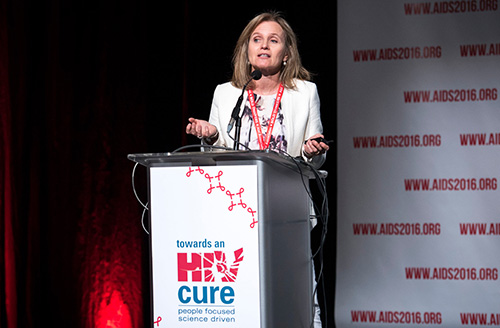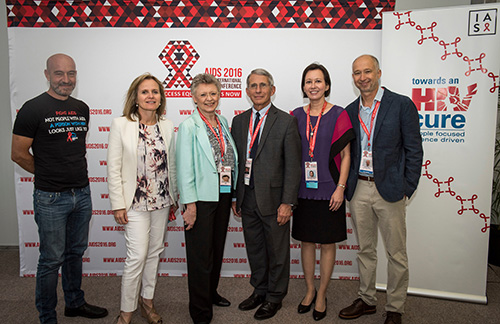Professor Sharon Lewin is Director of the Peter Doherty Institute for Infection and Immunity at the University of Melbourne, where she leads a large multidisciplinary research team that focuses on HIV persistence, cure research, and co-infections. An amfAR grantee, Dr. Lewin co-chaired the fifth annual Towards an HIV Cure Symposium preceding the 2016 International AIDS Conference in Durban, South Africa, in July. She recently visited amfAR’s offices in New York, where she spoke with amfAR Vice President and Director of Research Dr. Rowena Johnston.

Dr. Lewin speaks at the Towards an HIV Cure Symposium, Durban, South Africa, July 2016.
Dr. Johnston: Last summer, you received a four-year amfAR Impact grant to test cancer drugs in HIV. Can you tell us about the project and what you hope to achieve?
Dr. Lewin: Immune checkpoints are proteins that keep T-cells nonfunctioning. If you block those immune checkpoint proteins, the immune system can rev up again and start to recognize cancer, and we hope could recognize HIV. The Impact grant will let us study immune checkpoint blockers in combinations. In previous skin cancer studies, the use of two immune checkpoint blockers was more likely to increase the immune response to infected cells. We think this could play an important part in a cure for HIV as well.
Dr. Johnston: What kind of cancers are currently being treated by these drugs? How could the drugs be used to potentially cure HIV?
Dr. Lewin: The drugs have been licensed for the treatment of melanoma and lung cancer, and are being investigated in solid organ tumors and even blood tumors. Since they have been tested in thousands of people with cancer, we have a good understanding of their safety profile. That’s very important when you're moving interventions into people living with HIV on antiretroviral therapy.
There are many overlaps in HIV cure research and cancer research. In cancer you're going after these few cells that are left so the cancer won’t come back and in HIV you’re trying to reach the few persistent cells that are latently infected. In both settings there is inflammation, which dampens down an effective immune response, and in both settings you want to remove the target as well as boost the immune system response. In HIV, the target is latently infected cells; in cancer, it is malignant cells.

(Left to right): Giulio Maria Corbelli, Sharon Lewin, Françoise Barré-Sinoussi, Anthony Fauci, Jintanat Ananworanich, and Steven Deeks at the Towards an HIV Cure Press Conference, Durban, South Africa, July 2016
©International AIDS Society/Steve Forrest/Workers' Photos
Dr. Johnston: Do you think immune checkpoint blockers will work as a cure strategy by themselves or will they need to be used in combination with another intervention?
Dr. Lewin: It's possible they could work by themselves because they have a double action. In addition to boosting the immune system, they may be able to reverse latency by causing a latently infected cell or a cell that's not expressing any HIV on its surface to begin making HIV protein. Another possibility is that you could combine an immune checkpoint blocker with a vaccine to boost the vaccine’s responsiveness. This strategy is currently being used to treat cancer. You could also combine the immune checkpoint blocker with a latency reversing agent, which may boost or increase a part of the protein that the immune checkpoints need to work.
Dr. Johnston: The Impact grants represent the first time amfAR has committed funding over a four-year period. How has this longer funding period affected your research?
Dr. Lewin: It has had a huge impact because over four years you can plan a much bigger, more ambitious project. The impact grant has three parts: the basic science part, an animal project, and a clinical project. Each of those areas has different timelines and we're hoping to get synergies across them.
Dr. Johnston: You received your first amfAR grant in 2006 to investigate using chemokines to establish a model of latent infection. You, and in the meantime others, have used this model to test a number of cure approaches. What role did amfAR funding play in getting that model established, and getting you into the field of cure research?
Dr. Lewin: That project used chemokines to modify resting cells so you could develop a model of latency in vitro. At that time there were very few good models of latency. Now there are more. They're all a little bit different and we don't know which one best mimics patient-derived cells. The chemokine model looks at one aspect of latency where the cell's never been activated. Many other researchers now use that model, and many companies use that model to screen for new drugs.
In cancer you're going after these few cells that are left so the cancer won’t come back and in HIV you’re trying to reach the few persistent cells that are latently infected.
Dr. Johnston: As you say, that was ten years ago. How has cure research changed since then?
Dr. Lewin: The field has expanded dramatically. There are many more people working on different strategies. In 2006 we were focused on the virus and on characterizing latently infected cells. Since then we've shown that we can disrupt latency in vivo. We've learned about HIV remission. We've learned that HIV can be cured. (The Berlin patient wasn't reported until 2009.) We've learned that the immune response is key, and tiny amounts of virus can persist and cause trouble down the track when a person stops ART.
Dr. Johnston: What do you consider to be the most exciting cure possibilities on the horizon?
Dr. Lewin: There are many interesting proposals for gene therapy and some very good animal models to test those interventions. There's a shift now into developing and focusing on long-term immune control, not just attacking the reservoir and reducing how much virus persists. These strategies may involve vaccinations or immunomodulation, including immune checkpoint blockers. I think we will be hearing more about combination studies.
Dr. Johnston: What role has amfAR funding played in your career and its successes and what do you think an amfAR grant enables you to do that a grant from some other funding agency might not?
Dr. Lewin: amfAR has played a huge role in much of my work, starting with my first grant, when amfAR funded my proposal on chemokines and latency without a lot of preliminary data. Most funding agencies won’t do that—they want a high chance of return on their investment. But I think there needs to be funding for slightly more high-risk research as well as for safe and predictable work.
amfAR also funded my work on HIV/HBV co-infections, which is a big problem, particularly in Asia. amfAR awarded a Mathilde Krim fellowship to Megan Crane, who still works with me on understanding HIV, HBV, and immune activation, and how these viruses interact in ongoing liver disease. More recently amfAR funded an exciting clinical trial that we did in Melbourne and San Francisco to see whether disulfiram, a drug used to treat alcoholism, could also reverse latency. So amfAR has funded a spectrum of my work, including fundamental science, translational science, and clinical trials.
There's a shift now into developing and focusing on long-term immune control, not just attacking the reservoir and reducing how much virus persists.
Dr. Johnston: If there was one question that cure researchers need to answer right now that will really make the difference in the field's ability to move forward, what would that be?
Dr. Lewin: If I had to limit it to one question, I would say understanding viral rebound. It is assumed that it's coming from latently infected cells, or from persistent productively infected cells sitting in lymph nodes, or from cells other than T-cells. We have to understand where virus comes from that rebounds.
Dr. Johnston: How optimistic are you that we're going to find a cure or the scientific basis of a cure in the next five years?
Dr. Lewin: I'm pretty optimistic that we'll find a way to keep more people in long-term remission, meaning that their virus is kept at low levels without antiretroviral therapy. At the moment we have a handful of anecdotes of people in remission and I'm pretty confident that remission will be possible for a larger number of people. Most likely those will be people who are treated very early, or potentially babies born with HIV. The real challenge will be finding an intervention that can be translated to the many people diagnosed with HIV after living with the virus for years and years. But I think we're going to get somewhere in five years.